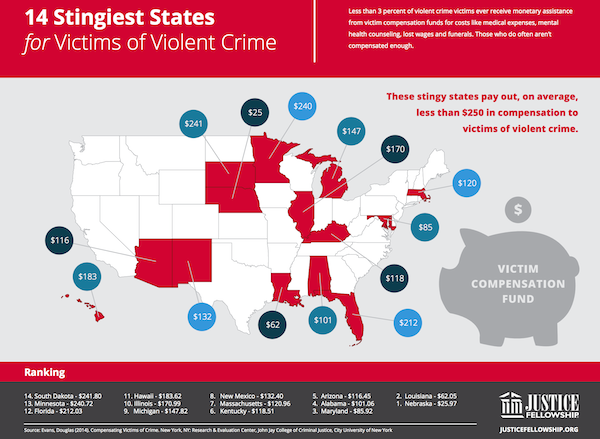Restorative justice is a theory of justice that emphasizes concepts such as reconciliation, forgiveness, and healing. There are, as Jordan Ballor has explained, a plurality of restorative justice movements. Yet one theme that is found in almost all forms is victim restitution, such as compensation funds for those who have been victims of crimes.
Such compensation rarely occurs, though. According to Justice Fellowship, less than 3 percent of violent crime victims ever receive monetary assistance from victim compensation funds for costs like medical expenses, mental health counseling, lost wages, and funerals. And those who do receive compensation don’t receive enough.
A report was commissioned by Justice Fellowship and developed by the John Jay College of Criminal Justice to examine the effectiveness of victim compensation programs. The report finds that very little of the billions of dollars placed within these funds goes directly to victims and survivors of crime:
Victim compensation funds are funded by criminal fines and taxpayer dollars and offer monetary assistance to victims and survivors of violent crime. Though similar in concept to restitution, they differ in eligibility requirements, funding sources, and distribution. Currently, victim compensation funds provide monetary assistance to only a small percentage victims and survivors of violent crime. Of the approximately 7 million victims of violent crime each year in the U.S., only 200,000 receive assistance from a compensation fund. Even more disturbing is the ratio of money spent on compensation compared to that which is spent on corrections. In 2012, federal, state, and local governments spent approximately $85 billion on corrections. In the same year, victim compensation funds paid out approximately $500 million dollars, or less than 1percent of what was spent on corrections.
This disparity cannot be blamed on a lack of funds. The Crime Victims Fund—a hybrid system funded jointly by federal and state dollars, but administered at the state level—currently retains a balance of almost $11 billion, while some states have additional balances that approach $10 million. Congress, however, has capped the total annual Crime Victims Fund spending at $745 million dollars, despite the large pool of victims who are eligible to receive funds and the surplus sitting in federal bank accounts. Further, the average maximum amount that victims and survivors can receive from a victim compensation fund by law is $26,000.
The full report can be found here.
Justice Fellowship also produced an infographic showing the “14 Stingiest States for Victims of Violent Crime.”


